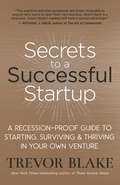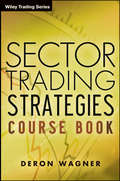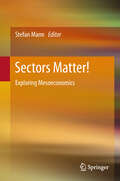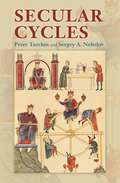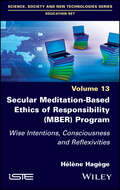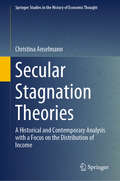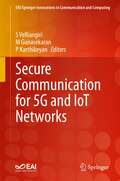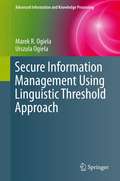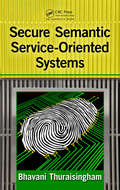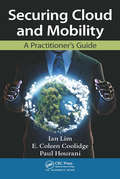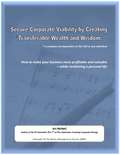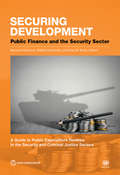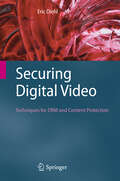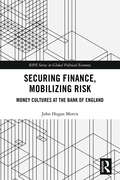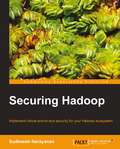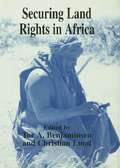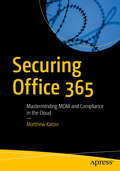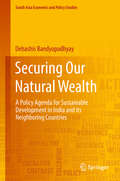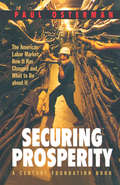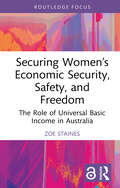- Table View
- List View
Secrets to a Successful Startup: A Recession-Proof Guide to Starting, Surviving & Thriving in Your Own Venture
by Trevor BlakeEverything You Need to Start and Succeed in Your Own Venture Trevor Blake built three successful startups and sold them for more than $300 million. Now he&’s written a complete instruction manual that covers everything the budding entrepreneur or existing business owner needs to know to build the career or business of their dreams. Unlike the many theoretical guides out there, this is a practical handbook based on Blake&’s wildly successful in-the-trenches experience. It incorporates leading-edge strategies that cover every aspect of running a business — including funding, developing systems, and marketing. Blake presents in-depth insight into managing effectively, maintaining cash flow, and adapting to the changing needs of customers in volatile economic times. One of his most innovative contributions is an emphasis on cultivating the right mindset, and he tells you exactly how to do that. &“The secret to success isn&’t in the plan,&” he writes. &“It&’s in the person holding it.&” His proven methods will give you the confidence to take the entrepreneurial leap and turn your winning idea into an efficient, profitable company.
Sector Trading Strategies
by Deron WagnerIntroducing Deron Wagner′s Sector Trading Strategies a brilliantly simple way to target profits in every market. Wagner walks you through his strategies for charting the market sectors, helping you determine if your stock, option, or other financial product is positioned for huge profit or actually at risk for a loss. Wagner focuses first on the skills necessary for sector trading identifying the realm of tradeable sectors, picking the best indicators, and analyzing risk then lays out his top three strategic methodologies for effective sector trading. To maximize the power of this guide, you′ll also receive access to an interactive online review tool at Traders′ Library′s Education Corner. Inside, learn the nuts and bolts of successful sector trading: The basics of reciprocal relationships and how to profit from them; How to follow mutual fund and other institutional money flow to find the next big trade; How and when to rotate your investment capital and optimize your returns; How to identify strong and weak sectors to place trades that have the best possible upside; Various methods for entering and exiting positions to gain and protect profits; How to increase your daily number of trading opportunities to exploit any market condition; How ETFs and options can be leveraged to get the most from the least; How to analyze risk to increase your trading peace of mind. To obtain the trading power of the big institutions, you need Wagner′s Sector Trading Strategies. With his help, you will be able to generate consistent profits no matter what the markets throw your way.
Sectors Matter!
by Stefan MannAlthough all economic activities take place in sectors, economists often devote little attention to differences between and characteristics of sectors. This book tries to show that mesoeconomics, the economic exploration of sectors and groups, is a useful instrument of analysis between microeconomics (the analysis of markets) and macroeconomics (the analysis of economies). In order to do so, economists and social scientists from related disciplines and coming from Europe, Australia and Asia, demonstrate that sectors matter for economic development and the formation of societies. The book includes chapters with rigorous economic analysis, outlooks on economic history, and case studies in order to show the relevance of sectoral issues, this broad range of content making it likely the most comprehensive book on mesoeconomics to date.
Secular Cycles
by Peter Turchin Sergey A. NefedovMany historical processes exhibit recurrent patterns of change. Century-long periods of population expansion come before long periods of stagnation and decline; the dynamics of prices mirror population oscillations; and states go through strong expansionist phases followed by periods of state failure, endemic sociopolitical instability, and territorial loss. Peter Turchin and Sergey Nefedov explore the dynamics and causal connections between such demographic, economic, and political variables in agrarian societies and offer detailed explanations for these long-term oscillations--what the authors call secular cycles. Secular Cycles elaborates and expands upon the demographic-structural theory first advanced by Jack Goldstone, which provides an explanation of long-term oscillations. This book tests that theory's specific and quantitative predictions by tracing the dynamics of population numbers, prices and real wages, elite numbers and incomes, state finances, and sociopolitical instability. Turchin and Nefedov study societies in England, France, and Russia during the medieval and early modern periods, and look back at the Roman Republic and Empire. Incorporating theoretical and quantitative history, the authors examine a specific model of historical change and, more generally, investigate the utility of the dynamical systems approach in historical applications. An indispensable and groundbreaking resource for a wide variety of social scientists, Secular Cycles will interest practitioners of economic history, historical sociology, complexity studies, and demography.
Secular Meditation-Based Ethics of Responsibility (MBER) Program: Wise Intentions, Consciousness and Reflexivities
by Helene HagègeSecular Stagnation Theories: A Historical and Contemporary Analysis with a Focus on the Distribution of Income (Springer Studies in the History of Economic Thought)
by Christina AnselmannIn light of weak economic performances and rising income disparities across the developed world during the past decades, this book provides a comprehensive overview of secular stagnation theories in the history of economic thought and examines the role of income distribution in various stagnation hypotheses. By offering a historical perspective, from the classical economists to the most recent stagnation debate of the early twenty-first century, the author shows that most stagnation theories were developed in periods of high and/or rising income disparities. Eventually, it was Josef Steindl, one of the least recognized stagnationists in the history of economic thought, who put the distribution of income at the heart of his stagnation theory. While Josef Steindl focused on the nexus between the functional distribution of income and economic growth, this book includes the personal distribution of income in a Kaleckian-Steindlian model of economic growth and stagnation. In the model presented, the nexus between economic growth and the distribution of income is a priori uncertain, depending on the type of economic shock and the specific economic circumstances. The author also discusses various empirically oriented policy implications aimed at fostering both economic growth and a more equal distribution of income. This book appeals to scholars in economics and the history of economic thought interested in economic growth, secular stagnation, and income distribution.
Secure Communication for 5G and IoT Networks (EAI/Springer Innovations in Communication and Computing)
by S. Velliangiri P. Karthikeyan M. GunasekaranThis book highlights research on secure communication of 5G and the Internet of Things (IoT) Networks, along with related areas to ensure secure and Internet-compatible IoT systems. The authors not only discuss 5G and IoT security and privacy challenges, but also energy efficient approaches to improving the ecosystems through communication. The book addresses the secure communication and privacy of the 5G and IoT technologies, while also revealing the impact of IoT technologies on several scenarios in smart city design. Intended as a comprehensive introduction, the book offers in-depth analysis and provides scientists, engineers and professionals the latest techniques, frameworks and strategies used in 5G and IoT technologies.
Secure Health: A Guide to Cybersecurity for Healthcare Managers
by Yassine Maleh Ahmed A. Abd El-Latif Mohamed Hammad Gauhar Ali Mohammed A. El-AffendiIn today’s interconnected world, healthcare systems are increasingly turning to digital technologies to enhance patient care and optimize operations. However, this digital transformation presents significant challenges in guaranteeing the security and privacy of sensitive healthcare data. Secure Health: A Guide to Cybersecurity for Healthcare Managers confronts these challenges head-on, offering a comprehensive exploration of the latest advancements and best practices in securing digital health systems.From examining the convergence of Internet of Things (IoT) applications with healthcare privacy and security to investigating ethical hacking frameworks and biometric access management, each chapter delves into valuable insights for safeguarding healthcare data in an ever-more digitized landscape. What sets this book apart is its holistic perspective, encompassing not only technical aspects but also governance standards, the unique cybersecurity challenges of telehealth, and the optimization of healthcare supply chain management.KEY FEATURES:• Explores the integration of IoT devices into healthcare and the associated privacy and security risks.• Examines security frameworks and best practices for e-health information governance.• Introduces a novel framework for ethical hacking in digital health.• Analyzes the effectiveness of different artificial intelligence (AI) models for botnet traffic classification.• Delves into the unique challenges of securing telehealth and remote monitoring systems.• Offers practical guidance on securing the future of e-health through smart sensor network management.
Secure Information Management Using Linguistic Threshold Approach
by Marek R. Ogiela Urszula OgielaIn recent years, cryptographic techniques for protecting and hiding secret information have been included in directions of research on intelligent information management. Data can be managed securely due to the use of algorithms for ensuring the confidentiality of data, information splitting techniques as well as protocols for sharing information and methods of its reconstruction. This is why techniques of advanced splitting and reconstruction of information form the primary subject of Secure Information Management Using Linguistic Threshold Approach, whose main purpose is to discuss the so-called linguistic threshold schemes for information sharing. An attempt is also made to describe the opportunities of using these techniques to create new models of managing strategic information shared within a commercial organisation or a state institution. Such information is specially protected, and its contents are used only if the authorised users are enabled to access it. This monograph attempts to define a model structure of information flow and for assigning information shares to particular groups of individuals concerned. The proposed information flow model can be integrated into practical solutions within any organisation or institution, improving the functionality of its legacy information systems. The use of strong mathematical cryptographic models to manage information constitutes a scientific innovation and a demonstration of the methods and opportunities of using advanced techniques for confidentially exchanging information in tasks supporting data flow within a commercial organisation. The interdisciplinary nature of the solutions proposed means that the subject of linguistic threshold schemes forming part of intelligent information management becomes a new challenge for the research and application work carried out.The authors of this monograph hope that it will guide readers on an interesting journey through the cutting edge solution in the field of secure information management.
Secure Semantic Service-Oriented Systems
by Bhavani ThuraisinghamAs the demand for data and information management continues to grow, so does the need to maintain and improve the security of databases, applications, and information systems. In order to effectively protect this data against evolving threats, an up-to-date understanding of the mechanisms for securing semantic Web technologies is essential. Reviewi
Securicor Wireless Networks: February 1996
by Bill Wasik G. Felda HardymonSecuricor Wireless (SWN) sold software products to wireless telephone carriers. The company was incorporated in January of 1995 as a 40%-owned subsidiary of Securicor Telesciences (STI), itself a wholly-owned subsidiary of British security giant Securicor PLC. Just over a year later, in February of 1996, SWN had the opportunity to merge with STI, creating a 70%-owned subsidiary of Securicor PLC and bringing it further under the umbrella of the British conglomerate. In presenting the events leading up to this decision, this case examines the dynamics of starting up a company with a large corporate investor, including the interplay between such a corporate partner and their traditional venture capitalist co-investors. Also touches on issues of corporate culture and differences in attitudes between U.S.-and U.K.-based companies/investors.
Securing Cloud and Mobility: A Practitioner's Guide (Systems Innovation Book Ser.)
by Ian Lim E. Coleen Coolidge Paul HouraniA practitioners' handbook on securing virtualization, cloud computing, and mobility, this book bridges academic theory with real world implementation. It provides pragmatic guidance on securing the multi-faceted layers of private and public cloud deployments as well as mobility infrastructures. The book offers in-depth coverage of implementation plans, workflows, process consideration points, and project planning. Topics covered include physical and virtual segregation, orchestration security, threat intelligence, identity management, cloud security assessments, cloud encryption services, audit and compliance, certifications, secure mobile architecture and secure mobile coding standards.
Securing Corporate Viability and Creating Transferable Wealth: How to make your business more profitable and valuable—while reclaiming a personal life
by Art McneilA strategic map for the owners of small to midsize businesses to help them survive and prosper in the "Shift-Age"...the post industrial era. Explains how to implement and balance inspirational leadership and process-
Securing Development: Public Finance and the Security Sector
by Bernard Harborne Paul M. Bisca William DorotinskySecuring Development: Public Finance and the Security Sector highlights the role of public finance in the delivery of security and criminal justice services. This book offers a framework for analyzing public financial management, financial transparency, and oversight, as well as expenditure policy issues that determine how to most appropriately manage security and justice services. The interplay among security, justice, and public finance is still a relatively unexplored area of development. Such a perspective can help security actors provide more professional, effective, and efficient security and justice services for citizens, while also strengthening systems for accountability. The book is the result of a project undertaken jointly by staff from the World Bank and the United Nations, integrating the disciplines where each institution holds a comparative advantage and a core mandate. The primary audience includes government officials bearing both security and financial responsibilities, staff of international organizations working on public expenditure management and security sector issues, academics, and development practitioners working in an advisory capacity.
Securing Digital Video: Techniques for DRM and Content Protection
by Eric DiehlContent protection and digital rights management (DRM) are fields that receive a lot of attention: content owners require systems that protect and maximize their revenues; consumers want backwards compatibility, while they fear that content owners will spy on their viewing habits; and academics are afraid that DRM may be a barrier to knowledge sharing. DRM technologies have a poor reputation and are not yet trusted. This book describes the key aspects of content protection and DRM systems, the objective being to demystify the technology and techniques. In the first part of the book, the author builds the foundations, with sections that cover the rationale for protecting digital video content; video piracy; current toolboxes that employ cryptography, watermarking, tamper resistance, and rights expression languages; different ways to model video content protection; and DRM. In the second part, he describes the main existing deployed solutions, including video ecosystems; how video is protected in broadcasting; descriptions of DRM systems, such as Microsoft's DRM and Apple's FairPlay; techniques for protecting prerecorded content distributed using DVDs or Blu-ray; and future methods used to protect content within the home network. The final part of the book looks towards future research topics, and the key problem of interoperability. While the book focuses on protecting video content, the DRM principles and technologies described are also used to protect many other types of content, such as ebooks, documents and games. The book will be of value to industrial researchers and engineers developing related technologies, academics and students in information security, cryptography and media systems, and engaged consumers.
Securing Electricity Supply in the Cyber Age: Exploring the Risks of Information and Communication Technology in Tomorrow's Electricity Infrastructure
by Margot P. Weijnen Zofia Lukszo Geert DeconinckThe electricity infrastructure is one of society's most critical infrastructures. The complexity of the electricity infrastructure system is increasing quickly, due to the increasing intensity of market-based power exchanges between electricity systems, the associated market restructuring and an increasing share of decentralized generation. As a consequence, the organizational complexity of power systems has exploded. At the same time, there is a shift in public and societal goals towards low-carbon and sustainable power generation. This will eventually require a drastic transformation of the industry. Increasingly, ICT is being depended upon for managing this infrastructure, for technical control and operation and for facilitating markets. A recent example is demand-side management, based on detailed metering of consumption and decentralized electricity generation. The mutual dependence of the electricity and the ICT infrastructures raises challenging questions in the areas of dependability, security and resilience. Examples include vulnerability to (cyber) attacks, avoiding and repairing technical failures and protecting data confidentiality, while guaranteeing accessibility. Therefore, better models and methods for protection against exploits of system vulnerabilities, whether accidental or intentional such as in cyber attacks, are called for. To address the above mentioned problems an advanced research workshop: "Electricity security in the cyber age: Managing the increasing dependence of the electricity infrastructure on ICT" was organized in the Netherlands in May 2009. The objective of the workshop was to contribute to the security of current and future electricity infrastructures by analyzing the risks that are caused by the increasing reliance upon ICT and investigating options for managing these risks. The book presents the contributions to the workshop by distinguished invited keynote speakers and participants from the international scientific and industrial community.
Securing Finance, Mobilizing Risk: Money Cultures at the Bank of England (RIPE Series in Global Political Economy)
by John MorrisDrawing on the history of modern finance, as well as the sociology of money and risk, this book examines how cultural understandings of finance have contributed to the increased capitalization of the UK financial system following the Global Financial Crisis. Providing both a geographically-inflected analysis and re-appraisal of the concept of performativity, it demonstrates that financial risk management has a spatiality that helps to inform understandings and imaginaries of the risks associated with money and finance. The book traces the development of understandings of risk at the Bank of England, with an analysis that spans some 1,000 reports, documents and speeches alongside elite interviews with past and present employees at the central bank. The author argues that the Bank has moved from a relatively broad-brush approach to the risks being managed in the financial sector, to a greater preoccupation with the understanding and mapping of the mobilization of financial risk. The study of financial practices from a critical social sciences and humanities perspective has grown rapidly since the Global Financial Crisis and this book will be of interest to multiple subject areas including IPE, economic geography, sociology of finance and critical security studies.
Securing Hadoop
by Sudheesh NarayananThis book is a step-by-step tutorial filled with practical examples which will focus mainly on the key security tools and implementation techniques of Hadoop security.This book is great for Hadoop practitioners (solution architects, Hadoop administrators, developers, and Hadoop project managers) who are looking to get a good grounding in what Kerberos is all about and who wish to learn how to implement end-to-end Hadoop security within an enterprise setup. It's assumed that you will have some basic understanding of Hadoop as well as be familiar with some basic security concepts.
Securing Land Rights in Africa
by Christian Lund Tor A. BenjaminsenThis collection of research papers from across the African continent illustrates the complex and ever-changing rules of the land tenure game, and how government legislation and reform (formalization) interact with local innovations (informalization) to form land tenure systems.
Securing Office 365: Masterminding MDM and Compliance in the Cloud
by Matthew KatzerUnderstand common security pitfalls and discover weak points in your organization’s data security, and what you can do to combat them. This book includes the best approaches to managing mobile devices both on your local network and outside the office.Data breaches, compliance fines, and distribution of personally identifiable information (PII) without encryption or safeguards place businesses of all types at risk. In today’s electronic world, you must have a secure digital footprint that is based on business processes that are designed to protect information. This book is written for business owners, chief information security officers (CISO), and IT managers who want to securely configure Office 365. You will follow the Microsoft cybersecurity road map through a progressive tutorial on how to configure the security services in Office 365 to protect and manage your business.What You’ll LearnManage security with the Azure Security Center and the Office 365 Compliance CenterConfigure information protection for document and electronic communicationsMonitor security for your business in the cloudUnderstand Mobile Application Management (MAM) and Mobile Device Management (MDM)Prevent data loss in Office 365Configure and manage the compliance manager tools for NIST and GDPRWho This Book Is ForIT managers and compliance and cybersecurity officers who have responsibility for compliance and data security in their business
Securing Our Natural Wealth: A Policy Agenda for Sustainable Development in India and for Its Neighboring Countries (South Asia Economic and Policy Studies)
by Debashis BandyopadhyayThis book explores various aspects of Intellectual Property Rights (IPR) regimes with regard to plant-variety protection and farmers’ rights; traditional knowledge; geographical indications, genetically modified crops; and access to genetic resources within the broad ambit of Trade-Related Aspects of Intellectual Property Rights (TRIPS), the Convention of Biological Diversity and other treaties/protocols. Enumerating the governance provisions for India and some of its neighboring countries, including Nepal, Sri Lanka, Bangladesh, Bhutan, Thailand and Myanmar, the book synthesizes a policy agenda to drive sustainable development. Further, it assesses and interprets the status quo, and discusses key issues and implications. By comparing various governance frameworks in South Asian countries, it attempts to bridge policy issues concerning development, IPR and international studies.
Securing Paradise: Tourism and Militarism in Hawai'i and the Philippines
by Gonzalez Vernadette VicuñaIn Securing Paradise, Vernadette Vicuña Gonzalez shows how tourism and militarism have functioned together in Hawaii and the Philippines, jointly empowering the United States to assert its geostrategic and economic interests in the Pacific. She does so by interpreting fiction, closely examining colonial and military construction projects, and delving into present-day tourist practices, spaces, and narratives. For instance, in both Hawaii and the Philippines, U. S. military modes of mobility, control, and surveillance enable scenic tourist byways. Past and present U. S. military posts, such as the Clark and Subic Bases and the Pearl Harbor complex, have been reincarnated as destinations for tourists interested in World War II. The history of the U. S. military is foundational to tourist itineraries and imaginations in such sites. At the same time, U. S. military dominance is reinforced by the logics and practices of mobility and consumption underlying modern tourism. Working in tandem, militarism and tourism produce gendered structures of feeling and formations of knowledge. These become routinized into everyday life in Hawaii and the Philippines, inculcating U. S. imperialism in the Pacific.
Securing Pension Provision: The Challenge of Reforming the Age of Entitlement
by Catherine BlairBy comparing Germany, France, the UK and the USA this study explores how governments have tackled the increased pressure of financing state pensions. Specifically, it looks at the approach of each of these countries to raising the age of entitlement in order to understand the ways in which this policy was introduced in different countries.
Securing Prosperity: The American Labor Market: How It Has Changed and What to Do about It
by Paul OstermanWe live in an age of economic paradox. The dynamism of America's economy is astounding--the country's industries are the most productive in the world and spin off new products and ideas at a bewildering pace. Yet Americans feel deeply uneasy about their economic future. The reason, Paul Osterman explains, is that our recent prosperity is built on the ruins of the once reassuring postwar labor market. Workers can no longer expect stable, full-time jobs and steadily rising incomes. Instead, they face stagnant wages, layoffs, rising inequality, and the increased likelihood of merely temporary work. In Securing Prosperity, Osterman explains in clear, accessible terms why these changes have occurred and lays out an innovative plan for new economic institutions that promises a more secure future. Osterman begins by sketching the rise and fall of the postwar labor market, showing that firms have been the driving force behind recent change. He draws on original surveys of nearly 1,000 corporations to demonstrate that firms have reorganized and downsized not just for the obvious reasons--technological advances and shifts in capital markets--but also to take advantage of new, team-oriented ways of working. We can't turn the clock back, Osterman writes, since that would strip firms of the ability to compete. But he also argues that we should not simply give ourselves up to the mercies of the market. Osterman argues that new policies must engage on two fronts: addressing both higher rates of mobility in the labor market and a major shift in the balance of power against employees. To deal with greater mobility, Osterman argues for portable benefits, a stronger Unemployment Insurance system, and new labor market intermediaries to help workers navigate the labor market. To redress the imbalance of power, Osterman assesses the possibilities of reforming corporate governance but concludes the best approach is to promote "countervailing power" through innovative unions and creative strategies for organizing employee voice in communities. Osterman gives life to these arguments with numerous examples of promising institutional experiments.
Securing Women’s Economic Security, Safety, and Freedom: The Role of Universal Basic Income in Australia
by Zoe StainesUniversal basic income (UBI) as a policy measure for supporting economic security has attracted worldwide attention. This book contributes to the discussion by focusing on UBI’s potential impacts for women, including women of colour and First Nations women.Utilizing a “scenario interviewing” approach, the author worked with 26 diverse Australian women to imagine the potential implications of UBI for their own lives, as well as for women more broadly. The women talked about a range of possible impacts including poverty reduction, economic security, improved autonomy, and freedom from violence, which are sorted into overarching themes and chapters. Integrating these women’s narratives into the key arguments for and against UBI, this book provides a robust and readable introduction to relevant literature.This book is suitable for a wide audience including scholars and students across the social sciences, as well as policymakers.
